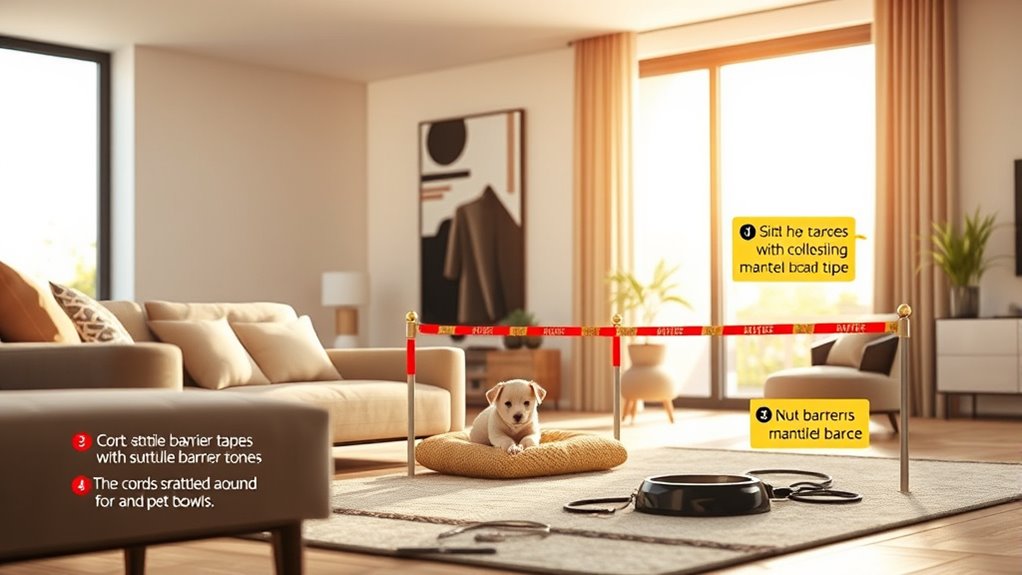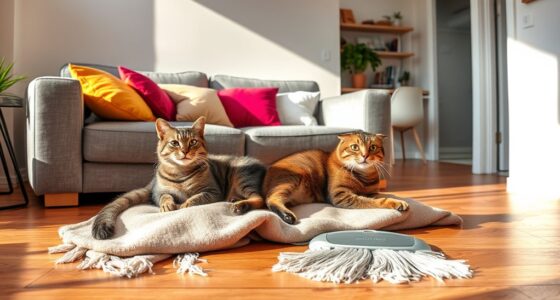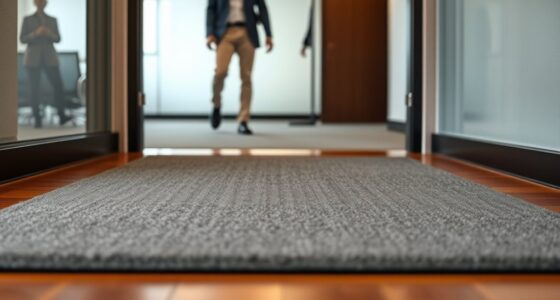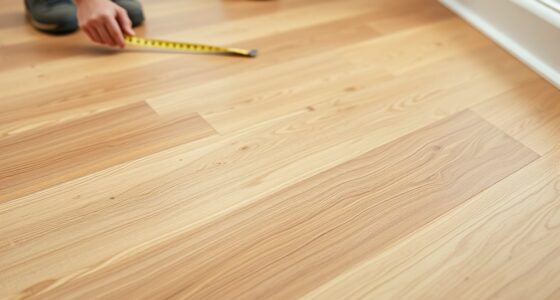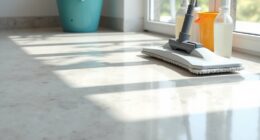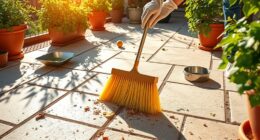To keep your pets safe, set clear no-go lines around electrical cords and food bowls. Use cord covers, hide cords behind furniture, or create designated safe zones where pets aren’t allowed to chew or access food. Establish boundaries with gates or barriers to prevent curiosity from turning into danger. By creating these safe zones, you protect your furry friends from electrical shocks, ingestion risks, and injuries. If you want to learn more about effective pet-proofing strategies, stay tuned.
Key Takeaways
- Establish no-go zones with barriers or gates around cords and bowls to prevent pet access.
- Use cord covers, sleeves, or organizers to hide and protect electrical wires from chewing.
- Place food and water bowls on non-slip mats in designated areas away from high traffic.
- Secure or remove hazardous household items and sharp objects from pet reach.
- Create clear boundary lines around unsafe furniture, elevated surfaces, and potential fall zones.

When designing a pet-friendly home, it’s essential to recognize certain areas or features that shouldn’t be crossed or used by your pets. These no-go zones help keep your furry friends safe and prevent accidents or damage. One of the most common hazards in any home involves electrical cords and wires. Pets, especially puppies and kittens, are curious by nature and love to chew or tug on anything within reach. If you don’t create clear boundaries, they might chew through cords connected to appliances, lamps, or chargers. This not only damages your electronics but also puts your pet at risk of electrical shock. To avoid this, consider running cords through protective sleeves or behind furniture. You can also use cord organizers or covers that make cords less accessible and less tempting to chew.
Create no-go zones for cords to keep pets safe from chewing and electrical hazards.
Another critical no-go line involves food and water bowls. While it might seem harmless to leave bowls out, you should establish designated areas where your pets can eat and drink. Placing bowls in high-traffic zones or near clutter can lead to spills and messes, which might cause your pet to slip or ingest something harmful. Furthermore, some foods and plants are toxic to pets, so keeping bowls away from areas where they could knock over or ingest from is essential. Use placemats or mats under the bowls to contain spills, and clean up regularly to maintain hygiene. Creating a specific feeding spot also helps your pet associate that area with mealtime, reducing the likelihood of them rummaging through trash or chewing on other household items. Additionally, proper placement of bowls can help prevent contamination and promote better digestion for your pets.
In addition to cords and bowls, you should establish boundaries around dangerous household items. For example, cleaning supplies, medications, or sharp objects should be kept out of reach or behind child-proof locks. These are no-go zones because pets can easily knock them over or swallow something harmful. Installing baby gates or using pet-proof barriers can block access to rooms or cabinets containing these hazards. Avoid leaving small objects on counters or tables that pets could swallow, as this can cause choking or internal injuries.
Finally, be mindful of furniture or areas where your pet could get trapped or injured. Sharp furniture edges, open windows, or balconies should be off-limits unless adequately secured. Use safety locks on windows and screens to prevent falls, and teach your pets to avoid climbing or jumping onto dangerous spots. By establishing clear no-go lines around these hazards, you make your home safer and more comfortable for your pets. Remember, setting boundaries isn’t about restricting your pet’s freedom but rather about protecting them from harm and ensuring everyone’s peace of mind.
Frequently Asked Questions
How Can I Secure Cords to Prevent Pet Chewing?
You can secure cords by using cord protectors or sleeves that hide and shield them from your pet’s teeth. Fix loose cords along baseboards or behind furniture to keep them out of reach. Use cord clips or ties to keep them neat and prevent chewing. Additionally, spray bitter-tasting deterrents on cords to discourage biting. Regularly supervise your pet and provide plenty of chew toys to redirect their chewing habits.
What Materials Are Safest for Pet Bowls?
You should use stainless steel or ceramic for pet bowls because they’re durable, non-toxic, and easy to clean. Avoid plastic, as it can harbor bacteria and may contain harmful chemicals like BPA. Silicone bowls are also safe, flexible, and chew-resistant, making them a good option. confirm the bowls are free of sharp edges and small parts to prevent injury or choking. Regularly inspect and replace worn bowls for your pet’s safety.
Are There Specific No-Go Zones for Cats Versus Dogs?
Cats tend to target tempting territories like countertops and high shelves, so set specific safe spaces away from these zones. Dogs, on the other hand, often explore lower areas and chew on cords or shoes. To keep both safe, establish clear no-go zones—use barriers or boundaries—and train your pets to stay within their designated domains. Consistent cues and calm corrections help them understand what’s off-limits.
How Often Should I Inspect Cords and Bowls for Safety?
You should inspect cords and bowls weekly to guarantee safety. Regular checks let you spot frayed cords, loose wiring, or damaged bowls before your pet gets hurt. Keep an eye out for signs of wear, and replace or repair items promptly. Frequent inspections help maintain a safe environment, preventing accidents. Make it a routine part of your pet care to keep your furry friend protected and happy at all times.
Can Pet-Safe Deterrent Sprays Keep Pets Away From Cords?
Yes, pet-safe deterrent sprays can help keep your pets away from cords. They emit a scent that pets find unpleasant but are safe for animals and humans. You should spray these around cords and other off-limits areas regularly to reinforce boundaries. Keep in mind, however, that sprays work best when combined with training and other safety measures, like covering cords or using pet-proof protectors.
Conclusion
Remember, the no-go lines we set for your pet’s home aren’t just safety measures—they’re small acts of love. When you think about how many times a stray cord or an uncovered bowl could cause harm, it’s almost like the universe nudges you to make those safe choices. By keeping these lines in place, you’re not just protecting your pet; you’re also creating a cozy, worry-free space where happy moments can unfold naturally.
